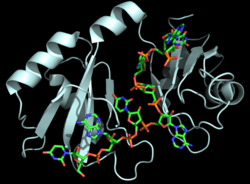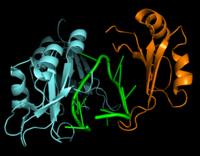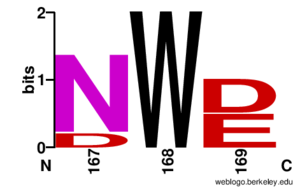Nuclear polyadenylated RNA-binding protein
From Proteopedia
(Difference between revisions)
| Line 1: | Line 1: | ||
| + | <StructureSection load='2cjk' size='400' side='right' caption='Hrp1-PEE Complex' scene='78/781945/Hrp1_and_pee/1'> | ||
| + | |||
=Introduction= | =Introduction= | ||
[[Image:Hrp1 fig1 cropped.png|250 px|right|thumb|Figure 1: Cartoon representation of the Hrp1-PEE complex. The RNA is shown as a stick model and is colored by element.]] | [[Image:Hrp1 fig1 cropped.png|250 px|right|thumb|Figure 1: Cartoon representation of the Hrp1-PEE complex. The RNA is shown as a stick model and is colored by element.]] | ||
Hrp1 is a [https://en.wikipedia.org/wiki/Polyadenylation polyadenylation] factor found in ''Saccharomyces cervisiae'' (yeast) <ref name="GM3H">PMID: 16794580</ref>. Hrp1 specifically recognizes and binds to an RNA sequence in the [https://en.wikipedia.org/wiki/Three_prime_untranslated_region 3'UTR] of the [https://en.wikipedia.org/wiki/Messenger_RNA messenger RNA (mRNA)] upstream from the cleavage site called the polyadenylation enhancement element (PEE) (Figure 1) <ref name="GM3H"/>. Upon binding to the RNA, Hrp1 helps recruit additional proteins necessary for the cleavage and polyadenylation of the RNA molecule <ref name="GM3H"/>. Although Hrp1 shares several common features with other RNA-binding proteins, the unique structural features of the Hrp1-PEE complex reveals the mechanism by which Hrp1 is able to recognize and bind to its specific RNA sequence at the atomic level <ref name="GM3H"/>. Hrp1 was discovered when Cleavage Factor I (CF I) was purified and separated into its two components, CF IA and CF IB. CF IB is a single 73 kDa polypeptide. The polypeptide was digested and two tryptic peptides were obtained for sequencing. The sequences were aligned via a database, and Hrp1 was determined to be a perfect match. Hrp1 of CF IB interacts with Rna14 and Rna15 of CF IA<ref name="RNA15"/> to form a protein complex that aids in cleavage, polyadenylation, and transport of the mRNA from the nucleus<ref name="KHSZ">PMID: 9334319</ref>. | Hrp1 is a [https://en.wikipedia.org/wiki/Polyadenylation polyadenylation] factor found in ''Saccharomyces cervisiae'' (yeast) <ref name="GM3H">PMID: 16794580</ref>. Hrp1 specifically recognizes and binds to an RNA sequence in the [https://en.wikipedia.org/wiki/Three_prime_untranslated_region 3'UTR] of the [https://en.wikipedia.org/wiki/Messenger_RNA messenger RNA (mRNA)] upstream from the cleavage site called the polyadenylation enhancement element (PEE) (Figure 1) <ref name="GM3H"/>. Upon binding to the RNA, Hrp1 helps recruit additional proteins necessary for the cleavage and polyadenylation of the RNA molecule <ref name="GM3H"/>. Although Hrp1 shares several common features with other RNA-binding proteins, the unique structural features of the Hrp1-PEE complex reveals the mechanism by which Hrp1 is able to recognize and bind to its specific RNA sequence at the atomic level <ref name="GM3H"/>. Hrp1 was discovered when Cleavage Factor I (CF I) was purified and separated into its two components, CF IA and CF IB. CF IB is a single 73 kDa polypeptide. The polypeptide was digested and two tryptic peptides were obtained for sequencing. The sequences were aligned via a database, and Hrp1 was determined to be a perfect match. Hrp1 of CF IB interacts with Rna14 and Rna15 of CF IA<ref name="RNA15"/> to form a protein complex that aids in cleavage, polyadenylation, and transport of the mRNA from the nucleus<ref name="KHSZ">PMID: 9334319</ref>. | ||
| - | |||
| - | |||
| - | |||
| - | |||
| - | |||
| - | |||
=Structure= | =Structure= | ||
| - | <StructureSection load='2cjk' size='400' side='right' caption='Hrp1-PEE Complex' scene='78/781945/Hrp1_and_pee/1'> | ||
==General Features== | ==General Features== | ||
Hrp1 is a single strand [https://en.wikipedia.org/wiki/RNA-binding_protein RNA-binding protein] composed of two RNP-type [https://en.wikipedia.org/wiki/RNA_recognition_motif RNA-binding domains (RBDs)] arranged in tandem with a typical ßαßßαß architecture <ref name="GM3H"/>. The two RBDs have similar topolgies, both containing a central [https://en.wikipedia.org/wiki/Beta_sheet antiparallel] four-stranded <scene name='78/783765/Beta_sheet/1'>ß-sheet</scene> with two [https://en.wikipedia.org/wiki/Alpha_helix α-helices] running across one face <ref name="GM3H"/>. The two RBDs associate to form a deep and positively charged <scene name='78/781960/Hrp1-rna_interface_surface/2'>cleft</scene>, which constitutes the binding site for the RNA molecule <ref name="GM3H"/>. | Hrp1 is a single strand [https://en.wikipedia.org/wiki/RNA-binding_protein RNA-binding protein] composed of two RNP-type [https://en.wikipedia.org/wiki/RNA_recognition_motif RNA-binding domains (RBDs)] arranged in tandem with a typical ßαßßαß architecture <ref name="GM3H"/>. The two RBDs have similar topolgies, both containing a central [https://en.wikipedia.org/wiki/Beta_sheet antiparallel] four-stranded <scene name='78/783765/Beta_sheet/1'>ß-sheet</scene> with two [https://en.wikipedia.org/wiki/Alpha_helix α-helices] running across one face <ref name="GM3H"/>. The two RBDs associate to form a deep and positively charged <scene name='78/781960/Hrp1-rna_interface_surface/2'>cleft</scene>, which constitutes the binding site for the RNA molecule <ref name="GM3H"/>. | ||
| Line 20: | Line 15: | ||
==RBD-RBD Interactions and the Linker Region== | ==RBD-RBD Interactions and the Linker Region== | ||
As mentioned above, Hrp1 is composed of two RBDs. The RBDs are connected by a <scene name='78/783765/Linker/3'>linker region</scene> (a short two-turn α-helix) which also contains an crucial residue for RNA binding. Ile234 holds Ade6 stacked in place with Phe162 <scene name='78/781945/Linker_rna/1'>via van der Waals contacts</scene>. Experimental evidence from the NMR data <ref name="GM3H"/> suggests that the two RBDs at independently until binding the PEE. Binding the PEE causes the linker region to adopt a short helical structure to rigidly hold the <scene name='78/781945/Protein_domains/2'>RBDs in place relative to each other</scene>. Aside from the linker helix, the only interaction between the RBDs is due to <scene name='78/781945/Interaction_between_domains/5'>a single salt bridge</scene> between Lys231 and Asp271 <ref name="GM3H"/>. | As mentioned above, Hrp1 is composed of two RBDs. The RBDs are connected by a <scene name='78/783765/Linker/3'>linker region</scene> (a short two-turn α-helix) which also contains an crucial residue for RNA binding. Ile234 holds Ade6 stacked in place with Phe162 <scene name='78/781945/Linker_rna/1'>via van der Waals contacts</scene>. Experimental evidence from the NMR data <ref name="GM3H"/> suggests that the two RBDs at independently until binding the PEE. Binding the PEE causes the linker region to adopt a short helical structure to rigidly hold the <scene name='78/781945/Protein_domains/2'>RBDs in place relative to each other</scene>. Aside from the linker helix, the only interaction between the RBDs is due to <scene name='78/781945/Interaction_between_domains/5'>a single salt bridge</scene> between Lys231 and Asp271 <ref name="GM3H"/>. | ||
| - | </StructureSection> | ||
[[Image:Hrp1 RNA15 Cropped.png|200 px|left|thumb|Figure 2: Interaction between Hrp1 (blue), RNA15 (orange) and RNA (green).]] | [[Image:Hrp1 RNA15 Cropped.png|200 px|left|thumb|Figure 2: Interaction between Hrp1 (blue), RNA15 (orange) and RNA (green).]] | ||
| Line 31: | Line 25: | ||
=Relationship to other proteins= | =Relationship to other proteins= | ||
The RNP-type RBD is found in many proteins involved in post-transcriptional [https://en.wikipedia.org/wiki/Post-transcriptional_modification pre-mRNA processing] (5'-end capping, splicing, 3'-end cleavage and polyadenylation, and transport from the nucleus)<ref name="RRMB">PMID: 18515081</ref>. The unique RBD of Hrp1 enables the protein to bind an RNA sequence that differs in both length and content from the RNA sequences of other RNA-binding and mRNA processing proteins such as [http://proteopedia.org/wiki/index.php/2sxl sex lethal], [https://en.wikipedia.org/wiki/Poly(A)-binding_protein Poly (A)-binding protein (PABP)], and [http://proteopedia.org/wiki/index.php/1fxl HuD] <ref name="GM3H"/>. Like Hrp1, each of these proteins belong to the class of single strand proteins composed of two canonical RBDs; however, these proteins are differentiated by their target RNA sequence, their interactions with RNA at the atomic level, and their interdomain contacts <ref name="GM3H"/>. One way in which Hrp1 differentiates itself from these other proteins is by the fact that Hud, sex lethal, and PABP all contain at least one intra-RNA base-base stacking interaction, a feature that is not found in the Hrp1-PEE complex <ref name="GM3H"/>. It is possible that the intra-RNA interactions found in these other proteins is replaced by the crucial Trp168-Ade4 stacking interaction found in the Hrp1 complex <ref name="GM3H"/>. The fact that the intra-RNA base-base stacking interactions are replaced by the Trp168-Ade4 in the Hrp1-PEE complex might also explain why the Hrp1-RNA interface involves only 6 nucleotides whereas PABP, sex lethal, and HuD require a longer 8-10 nucleotide sequence in the RNA binding pocket <ref name="GM3H"/>. | The RNP-type RBD is found in many proteins involved in post-transcriptional [https://en.wikipedia.org/wiki/Post-transcriptional_modification pre-mRNA processing] (5'-end capping, splicing, 3'-end cleavage and polyadenylation, and transport from the nucleus)<ref name="RRMB">PMID: 18515081</ref>. The unique RBD of Hrp1 enables the protein to bind an RNA sequence that differs in both length and content from the RNA sequences of other RNA-binding and mRNA processing proteins such as [http://proteopedia.org/wiki/index.php/2sxl sex lethal], [https://en.wikipedia.org/wiki/Poly(A)-binding_protein Poly (A)-binding protein (PABP)], and [http://proteopedia.org/wiki/index.php/1fxl HuD] <ref name="GM3H"/>. Like Hrp1, each of these proteins belong to the class of single strand proteins composed of two canonical RBDs; however, these proteins are differentiated by their target RNA sequence, their interactions with RNA at the atomic level, and their interdomain contacts <ref name="GM3H"/>. One way in which Hrp1 differentiates itself from these other proteins is by the fact that Hud, sex lethal, and PABP all contain at least one intra-RNA base-base stacking interaction, a feature that is not found in the Hrp1-PEE complex <ref name="GM3H"/>. It is possible that the intra-RNA interactions found in these other proteins is replaced by the crucial Trp168-Ade4 stacking interaction found in the Hrp1 complex <ref name="GM3H"/>. The fact that the intra-RNA base-base stacking interactions are replaced by the Trp168-Ade4 in the Hrp1-PEE complex might also explain why the Hrp1-RNA interface involves only 6 nucleotides whereas PABP, sex lethal, and HuD require a longer 8-10 nucleotide sequence in the RNA binding pocket <ref name="GM3H"/>. | ||
| - | + | </StructureSection> | |
| - | + | ||
=References= | =References= | ||
<references/> | <references/> | ||
Revision as of 15:45, 17 April 2018
| |||||||||||
References
- ↑ 1.00 1.01 1.02 1.03 1.04 1.05 1.06 1.07 1.08 1.09 1.10 1.11 1.12 1.13 1.14 1.15 1.16 1.17 1.18 1.19 1.20 1.21 Perez-Canadillas JM. Grabbing the message: structural basis of mRNA 3'UTR recognition by Hrp1. EMBO J. 2006 Jul 12;25(13):3167-78. Epub 2006 Jun 22. PMID:16794580
- ↑ 2.0 2.1 2.2 2.3 2.4 Leeper TC, Qu X, Lu C, Moore C, Varani G. Novel protein-protein contacts facilitate mRNA 3'-processing signal recognition by Rna15 and Hrp1. J Mol Biol. 2010 Aug 20;401(3):334-49. Epub 2010 Jun 19. PMID:20600122 doi:10.1016/j.jmb.2010.06.032
- ↑ Kessler MM, Henry MF, Shen E, Zhao J, Gross S, Silver PA, Moore CL. Hrp1, a sequence-specific RNA-binding protein that shuttles between the nucleus and the cytoplasm, is required for mRNA 3'-end formation in yeast. Genes Dev. 1997 Oct 1;11(19):2545-56. PMID:9334319
- ↑ Clery A, Blatter M, Allain FH. RNA recognition motifs: boring? Not quite. Curr Opin Struct Biol. 2008 Jun;18(3):290-8. doi: 10.1016/j.sbi.2008.04.002. PMID:18515081 doi:http://dx.doi.org/10.1016/j.sbi.2008.04.002
Proteopedia Page Contributors and Editors (what is this?)
Cory A. Wuerch, Matthew Douglas Moore, Savannah Davis, Michal Harel, Jaime Prilusky



